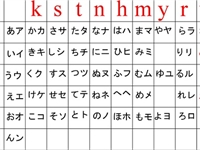
Strategies for Learning Hiragana and Katakana
Important Notice: Our web hosting provider recently started charging us for additional visits, which was unexpected. In response, we're seeking donations. Depending on the situation, we may explore different monetization options for our Community and Expert Contributors. It's crucial to provide more returns for their expertise and offer more Expert Validated Answers or AI Validated Answers. Learn more about our hosting issue here.

Strategies for Learning Hiragana and Katakana
You must be logged in to post a comment.
Kana consist of the two Japanese syllabaries, not exactly “alphabets,” known as hiragana and katakana. Hiragana is the first syllabary all Japanese language students learn, and it is the first that Japanese children learn in school as well. All Japanese words may be written in hiragana and many combine hiragana with a Kanji (Chinese characters) to form Japanese verbs, primarily, and other words.
Examples of hiragana:
こんにちは。(konnichiha) “hello”
行く(iku) “to go” [combines a Kanji with the hiragana “ku”]
お願いします。(onegaishimasu) “please”
私たち (watashitachi) “we”
Katakana consists of the same sounds as hiragana but is written differently. Katakana is used for all loan-words; words borrowed from other languages that the Japanese have modified to suit their pronunciation and adopted into the Japanese language. The katakana syllabary tends to give many Japanese language students difficulty, especially after mastering hiragana. Both contain 46 characters, but since katakana is not used as much during the beginning of most Japanese language courses it is a bit more difficult to memorize.
Examples of katakana:
アルバイト (arubaito) “part-time job” [German loan-word]
バス (basu) “bus”
トイレ (toire) “toilet; bathroom”
タイムスリップ (taimu surippu) “time slip” [common in anime and some dramas
Katakanaare also used to emphasize certain words, particularly in manga and for representing onomatopoeia, or words representing sounds or movements. Katakanais used to write animal words, as well.
Examples:
象 = ゾー (zou) “elephant”
ダダダダダ (dadadadada) [used to indicated “running” in comics, for example]
There is no trick to learning kana fast and easy, but you can make things easier on yourself by being consistent in your studies. To improve consistency, determine your reason(s) for wanting to know Japanese, but more specifically, why you want to know Japanese well. Anyone can learn to speak Japanese, but by ignoring the writing (hiragana, katakana, Kanji) you are only becoming an “illiterate” speaker; able to talk but not read or write. The following tips should prove helpful in learning the kana: